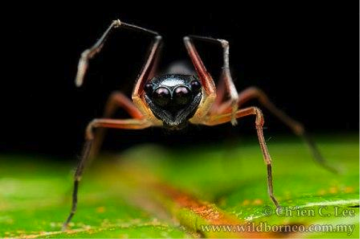Our lives at Lambir were more or less as at Mulu — breakfast by 8 and in the field by 9. Hike anywhere from a few minutes to an hour. Record latitude/longitude and other data. Sample intensely for 40 minutes, focusing on either tree trunks, foliage, or the ground. Record more data, and repeat for another 40 minute session, then again, then again, for a total of 6 sessions. Add time to take notes, have some lunch, wipe sweat, readjust gear, and it’s about 4 pm by the time we get back to camp.
We are overheated and absolutely exhausted, with barely enough energy to take showers. Then we have to process the specimens, which involves photography and preservation, usually until after 9 pm. We do have a break for dinner, but little time to relax otherwise. It takes a toll on us.
We structure our sampling by habitat to be able to standardize person-hours of effort in each habitat. This lets us quantify each species’ preference for habitat — for instance, we will recognize a species as a trunk-dweller by the fact that we find many more specimens of it per hour effort on trunks than we do on the ground. Learning about habitat preferences is key for us to get a very basic idea of each species’ ecology.
And, learning each species’ ecology is a key part of a big question we are asking with this study. I have characterized this expedition as one to find undiscovered biodiversity, and indeed that is a major goal. But we have another goal: we are comparing the basic habitat adaptations of jumping spiders in Borneo to those in South America. Back in the lab Edy will carefully measure body shapes to see if in general trunk-dwellers tend to differ from ground-dwellers and foliage dwellers — do they tend to be flatter and narrower and with shorter legs? — and whether any pattern is repeated in both the Sarawak and Ecuador samples.

A stunning portrait of an Agorius, a strange local salticid whose body looks like that of an ant. PHOTO: CH’IEN LEE
What makes this particularly interesting is that the Sarawak jumping spider species evolved largely independently from the Ecuador species. In an earlier post I had commented that biodiversity is local, and that in the case of salticids, large evolutionary groups tend to be local. This means that not only are individual species in Ecuador distinct from those in Sarawak, but the whole diversification of jumping spiders in Asia happened more or less independently from that in South America, like a separate evolutionary experiment.
Stephen Jay Gould once pondered the thought experiment, “if we could rewind the tape of the history of life, then play it again, would it come out the same way the next time?” (For the younger readers, ask someone older what is tape and why one would have to rewind it…) Gould’s expectation was that it would come out quite differently.
To explore this fundamental question about predictability versus contingency in evolution, we can’t rewind the tape. But sometimes, different branches of species lineages in the evolutionary tree of life were presented, separately, with similar challenges. Each of these lineages therefore played its own separate tape as its evolution unfolded. By comparing the histories of each lineage, we can see whether indeed the story had the same ending each time.
Because the Asian jumping spiders diversified independently from the South American ones, two separate copies of Gould’s tape were played, one on each continent. Are the stories the same? Do trunk dwellers show the same adaptations in Sarawak as they do in Ecuador? Are there as many trunk dwellers in both places? Did they take as many million years to adapt in both places? If not, why not? These are some of the questions we want to answer.
